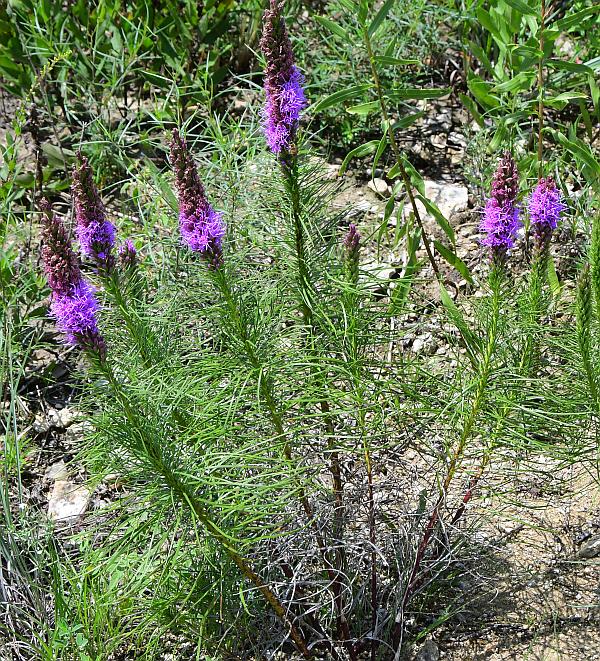Liatris mucronata DC.
Narrow-leaved Gayfeather

Native
CC = 10
CW = 5
MOC = 10
© SRTurner
Liatris mucronata DC.Narrow-leaved Gayfeather | |
 |
Native CC = 10 CW = 5 MOC = 10 |
© SRTurner |
|
Family - Asteraceae/Eupatorieae Habit - Perennial forb from a more or less globose corm. Stem - Ascending to erect, to 90 cm, usually multiple from the base, glabrous.
Leaves - Alternate, simple. Basal and adjacent lower stem leaves sessile to short-petiolate, the blades 7-15 cm long, 1-4 mm wide, linear, the narrow, light margins occasionally curled under, the surfaces glabrous, green, with 1 main vein, grading toward the stem tip to shorter leaves, these mostly sessile, 1.5-12.0 cm long, linear.
Inflorescence - Elongate spikes, the heads densely spaced (the axis mostly not visible between heads), sessile or nearly so, with 1 basal bract.
Heads - Discoid. Heads with 3-6 disc florets, the terminal head sometimes slightly longer than the others. Involucre 7-12 mm long, narrowly cupshaped to nearly cylindrical, with 4-6 unequal, overlapping series of bracts (the outer series appearing somewhat shorter). Involucral bracts broadly lanceolate to narrowly oblong-obovate, tapered to a sharply pointed, ascending to somewhat spreading tip, mostly with narrow, thin, pale to transparent margins, these sometimes slightly to strongly purplish-tinged, more or less entire but sometimes cobwebby-hairy, the main body appearing flat below the tip.
Flowers - Ray florets absent. Disk florets with the corollas 9-11 mm long, glabrous or the tube sparsely hairy on the inner surface toward the base, purple. Pappus bristles plumose.
Fruits - Achenes 5.5-7.5 mm long. Flowering - July - October. Habitat - Glades and bluffs, on limestone and dolomite substrates. Origin - Native to the U.S. Lookalikes - Liatris punctata, L. pycnostachya. Other info. - This relatively uncommon member of the Liatris genus is found in a handful of counties in the southern part of the state. Beyond Missouri its range extends in a band from eastern Kansas southward through Texas, nearly to the Gulf Coast. It is easily identified as a Liatris by its spikes of small purple florets which are contained in heads. The heads are crowded, such that the inflorescence axis is generally not visible. The plant most closely resembles L. punctata, and in fact is considered a variety of that species by some authors. The leaves of L. mucronata are glabrous whereas those of L. punctata usually have some hairs on the margins. There are also differences in the rootstocks, and the ranges of the two species in Missouri do not overlap. Nevertheless, the two can be difficult to distinguish in some cases. Photographs taken at Glade Top Trail National Scenic Byway, Ozark County, MO, 8-16-2023 (SRTurner). |